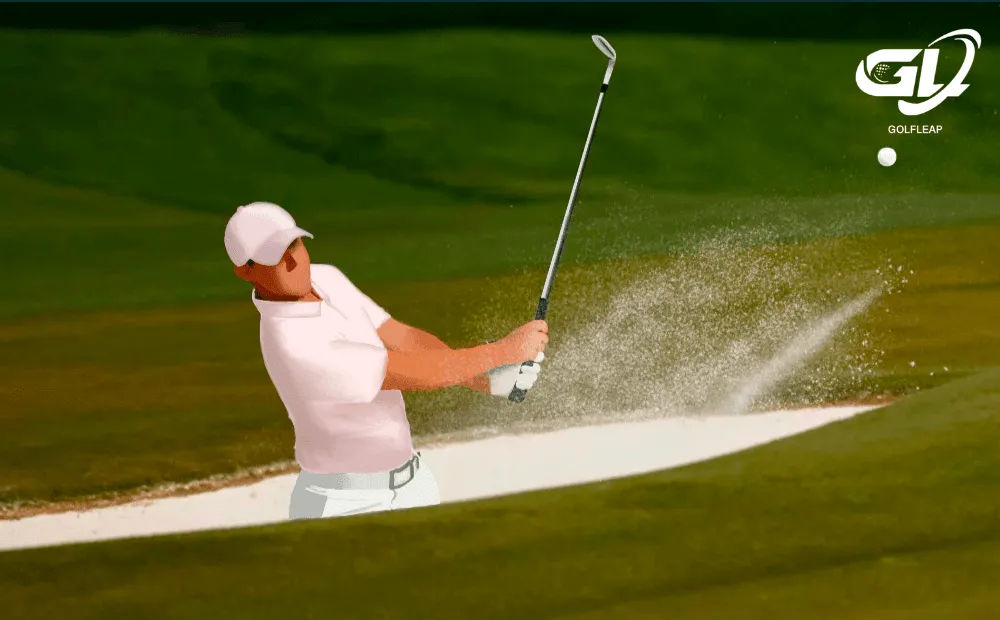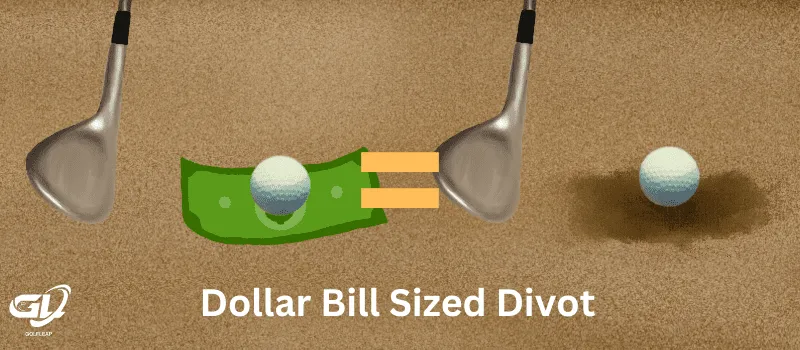
Not sure how to hit a bunker shot? We’ve got you covered.
Are you tired of feeling that pit of despair in your stomach when you see your ball sail toward a bunker? Sick of having to warn your group to “Look alive!” before you make your swing inside sand traps?
The truth is, bunker shots require a very different approach than every other type of golf shot, and every golfer feels these “unsure” emotions when faced with a shot they haven’t confidently practiced.
Thankfully, with the proper technique and instruction, we’ll break down in our guide today, bunker shots will become a challenge you embrace facing on the golf course.
Quick Summary On The Basics of Hitting A Bunker Shot
- Open the clubface,
- Open your stance,
- Widen your stance,
- Dig your feet in,
- Position the Ball slightly forward in your stance,
- Aim an inch or two behind the ball without touching the sand,
- Swing and create a 1 dollar bill-sized divot where the ball would have been at the center of that divot
Table of Contents
BUNKER BASICS: HOW TO HIT A BUNKER SHOT FOR BEGINNERS
As a golf instructor, I specialize in teaching beginners how to get started in golf. I see how embarrassing a sand shot can be for newbies. Before we get into Bunker Basics, I have good news for you!
When it comes to getting out of a bunker, a proper sand wedge will do 90% of the work for you. More on that later.
What Makes Bunker Shots Difficult for Many Players?
Bunker shots often feel more complicated than they are to beginner golfers because proper sand technique is rarely taught.
The most common problems beginners have in sand traps come from a lack of instruction including:
- Using the wrong wedge for the bunker type and length of shot
- Incorrect stance, ball position, and shaft angle at address
- Improper weight distribution during swing and contact
- Using chipping or pitching techniques in the bunker
- Too slow of swing / Too short of a follow-through
Proper Bunker Technique for Beginners
Wedge Selection Guide
As a beginner golfer, using your sand wedge or lob wedge with a loft ranging between 56° and 60°+ will be the best clubs for most of your bunker shots close to the green. Loft and bounce (the angle created between the leading edge and trailing edge of the wedge) are your best friends with bunker shots. Golfer’s sand and lob wedges have the most loft and bounce in a player’s golf bag, making them the easiest tools to use.
Higher bunker faces/lips or sand shots that need to get high quickly and land softly will be less difficult with a higher lofted lob wedge. More “standard bunker shots” (5 to 20 yards) with little height required to reach the green safely can be efficiently executed with a player’s regular sand wedge.
Be sure to stick around until the end of our article, where we talk about one of our favorite wedges of the 2022 season that has built-in features to make bunker shots even easier for its users!
Basic Bunker “Setup:” Stance, Ball Position, and Shaft Angle
A few unique steps are required to create a perfect bunker setup before making a swing. Nearly all this advice is only helpful for bunker shots, furthering the idea that a specific technique is needed for the sand game alone.
- Players should start by angling their lead foot and leg slightly open and more pointed toward the target. Feel free to widen your stance, dig your feet into the sand for a stable base, and have more knee bend than usual (This keeps the hands lower and loft higher for easier height on sand shots).
- A player’s feet should point parallel to your target, towards your target, or even to the right of the target (contrary to popular belief).

- The ball’s position in your stance should be forward of center and in line with the inside of your lead heel.
- Thanks to your new ball position, when looking down, the club’s shaft should be a straight line between just behind the ball and the inside of your leading heel with NO forward shaft lean. Forward shaft lean decreases loft and brings the hosel of the wedge into play. No forward shaft lean and even having your hands behind the ball at address keeps the loft high and bounce at a usable angle to “bounce” off the sand.
- Add more loft to the club head by opening the face before you take your grip. Even if the face points to the right of the target, since you’re not making contact with the ball in the sand, the ball’s direction will be based on your swing path, not your club face’s direction.
* Crucial bunker setup and swing tip! * Players should have 70% of their weight on their leading leg throughout the entire bunker swing and even more through and after impact. Weight on the rear leg at the address or during the swing results in the wedges leading edge being unpredictable, leading to chunky or thinned shots.
Hitting The Shot
Two things are essential to hitting consistent successful bunker shots: 1. The bounce of the wedge contacting the sand first to propel the ball forward, not the leading edge. 2. Maintain a high loft throughout the swing by releasing the club head past your hands through impact.
- As we’ve discussed, bunker shots do not require ball-first contact. Instead, golfers are looking to skip the club head off the sand like skipping a stone across water. Imagine a line an inch or two behind the ball, the bounce of the club head contacting the sand there, and the sand between the club face and the ball is what sends the golf ball out of the bunker.
Golfers will know they’re using the bounce correctly when they hear a distinctive “thud” sound when the club contacts the sand. Additionally, divots with proper bounce use are usually shallow and flat, whereas leading edge divots will be deeper and more angular.
- Maintain an open face through the start of the swing by “folding your rear elbow” vigorously during the back swing. While this goes against every other golf swing ideology, players will “release the club head” much more effortlessly and use the bounce to its full potential when their elbow straightens through impact. This unique-to-bunkers elbow motion also makes slapping the club’s bounce into the sand easier.
Players can ensure they are “releasing the club head fully” by ensuring the most speed during their swing is at impact and completing their swing with a longer follow-through. Beginner players will often become hesitant in bunkers and slow their swing down, even decelerating through impact. When this happens, the club head cannot release through impact, leading to inconsistent and unpredictable results.
The Dollar Bill Drill

- Continue your practice routine from above and imagine a dollar bill on the sand.
- Remember the sound and the feeling of sliding through the sand with your swing.
- Place a ball in the center of the imaginary dollar bill and take the shot.
- Your goal is to make your bunker shot feel and sound just like your practice swing.
- Hitting the sand first is the key. Imagine a dollar bill-sized splash of sand lifting your ball up and over the edge of the bunker.
- Remember, it is against the rules to take bunker practice swings during your round. Only in practice, can you get used to what it feels like to hit sand out of the bunker before you try with a ball.
What About Wet Bunkers?
More often than not, you’ll run into wet bunkers from the previous day’s rain. If it’s wet, you can sure bet that the shot you take with a wet bunker will be slightly different. That’s because the wet sand would be heavier and result in the acceleration of your swing being reduced.
To play a wet bunker effectively, here are some tips:
- Grip the club deeper/ lower → this allows you to swing more firmly when making contact with the harder and heavier sand.
- Skim the sand instead of plowing it → heavier sand dampens the acceleration of your swing, ruining your golf shot. Aim an inch or half an inch behind the ball and skim the club through the and so you don’t lose momentum in your golf swing.
- Consider using a lob wedge → this isn’t always the case, but if you struggle with swinging through wet bunkers, a higher loft wedge glides through the sand much easier.
Wedge Bounce for Bunker Shots
A wedge’s bounce angle is the angle between the trailing edge and the leading edge of your golf wedge and its main purpose is to prevent the club from digging too much into the ground when you’re hitting the sand.
Usually speaking, lower bounce wedges are better for firmer conditions and golfers that tend to take fewer divots. The video above by Mac McLeod shows this perfectly. Just note that the bounce you get on your wedge depends on the bunker conditions you encounter on the course. At times it may be good to have two wedges, one with a higher degree of bounce and the other lower to ensure you’re able to play effectively in both types of sand.
Old vs. New Bunker Shot Styles
Old-school teaching would tell beginner golfers to aim their feet 3-15 feet left of the target, open the face, and slice across the ball. Modern instructors have found that aiming the feet parallel or even right of the target and releasing the hands fully through impact (using the bounce properly), and swinging towards the target gives players a better chance of consistently getting good results out of the sand.
The video above shows the current World No. 1 Rory McIlroy explaining how he built more consistency and predictability into his sand game by perfecting his setup! Credits to the Me And My Golf Youtube Channel.
BONUS PRO BUNKER TIP: Make sure you always swing through to your finish into a natural follow-through. The weight of the club head is designed to help you. Don’t fight your club. Keep your arms loose.
Bunker Etiquette
As a beginner, you may continue to feel awkward and uncomfortable with bunker shots for a while. That is normal. One way to feel more accomplished and skilled is to maintain the bunker-like an expert player. Here is how:
- Leave your bag or park your cart between you and the next hole.
- Carry your putter and sand wedge to the bunker with you.
- Carry the bunker rake into the bunker with you and lay it nearby.
- Always enter the bunker as close to the ball as possible.
- After your ball is out of the bunker, use the rake to smooth the area where you took your shot.
- Be sure to walk out of the bunker on the same path you walked in. 7. Rake behind you as you exit the bunker
Picking the Right Sand Wedge for the Job
We touched briefly on the ideal wedge for greenside bunkers shots. For a quick recap, let’s dive into more detail on the essential components that made a good sand wedge that’ll help you get out of the bunker more easily.
FUNDAMENTAL FEATURES OF SAND WEDGES FOR BEGINNERS
- The sole of the club is the widest of all the irons and is designed to minimize missed hits. The cavity back design of the club head allows for maximum perimeter weighting making this club easy to hit.
- The loft or angle of the club face is engineered to get the ball high enough to get over the edge, or lip of the bunker. Generally, the higher the degree of loft, the easier the bunker shot for beginners.
- The club head has the heaviest swing weight the all the irons. This is a major reason the club is so good at getting out of bunkers.
- The bounce or “inverted sole” prevents the leading edge of the club from hitting the ground first. The extra wide sole slides through the sand naturally.
Here’s why we love the Titleist Vokey SM9 Wedges
Picking the right wedge for the job is also key to hitting out of the bunker. For absolute newbies to the sport, in most cases don’t use a 7-iron, or any iron for that matter when you’re stuck in the bunker! You’re go-to is the sand wedge.
If you’re looking for one of the best sand wedges that are going to help you in the bunkers significantly, we’d recommend grabbing the Titleist Vokey SM9 Wedge.
Without a doubt, Titleist manufactures some of the most sought-after wedges in the golfing community. That said, their Vokey line of wedges stands as the holy grail of the wedge category. In terms of attention to detail, quality of the build, forgiveness, and versatility, the Vokey SM9 stands above every other wedge right now.
The only downside? Well, you guessed it! Being a top-of-the-line Titleist golf club, the Vokey SM9 wedge will be priced at the higher end of the market. However, if you’re looking for something that would stay in your bag pretty much forever and take your bunker game seriously, then the Vokey SM9 won’t fail you.
Bunker Shot Frequently Asked Questions
What Changes to Hit Shorter or Longer Bunker Shots?
The speed of your golf swing and the length of your follow-through will drastically affect the distance the ball carries out of the sand. For example, for a short-sided bunker shot that only needs to carry 3-5 yards, I would use a 60° wedge, take a fast half swing, and abbreviate the follow-through to *hopefully impart more spin on the ball.
For a 20-yard bunker shot, I might use my 56° wedge and a longer, more flowing swing with a long complete follow-through to generate more carry and even roll once it hits the green.
How Do You Make a Bunker Shot Release and Roll After Hitting the Green?
If you’ve been around the game of golf long enough, you’ve likely heard the phrase “chunk and run.” This is the exact concept players should use when they want a bunker shot to release after it hits the green. Once you’re confident in your ability to hit the sand where you want to, make slightly steep and deeper contact behind the ball, and watch it run once it hits the putting surface! More sand between the club face and the ball results in less spin, meaning more roll!
Why can’t you use a pitching wedge out of the bunker?
The pitching wedge is designed to dig into the ground, making it excellent for some shots. You do not want your club to dig into the sand. A sand wedge is designed to slide through the sand.
Why can’t you take practice swings in the bunker?
This is simply one of the rules of golf. As you advance in your game, you will want to know the rules to avoid penalty strokes.
Can I practice bunkers at a beach?
Surprisingly, we’ve tried this before and yes you can! However, make sure there’s no one around or nearby that you may accidentally drop a golf ball on. Also, if you do decide to do this, practice at a patch of flat and fluffy sand.
Final Thoughts on Hitting Bunker Shots
Most golfers have no confidence when hitting out of the bunkers because they don’t have the experience, practice, and information to execute a proper bunker shot. However, if you take what we taught you above and start practicing at ranges with bunkers for you to practice, or simply start challenging yourself more frequently on the golf course you’re sure to see improvement!
If you liked what you read here, check out some other articles you may like:


